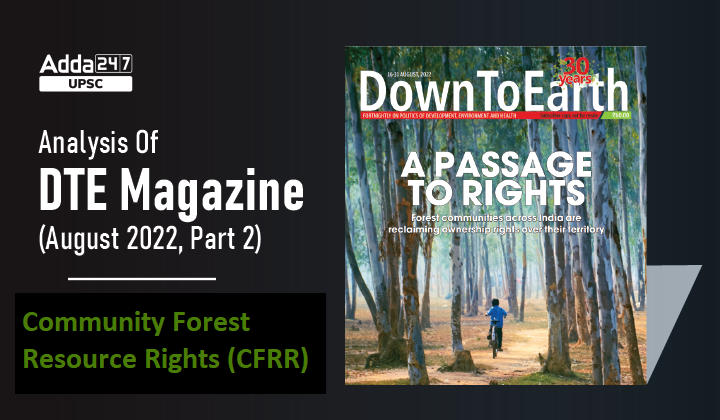Table of Contents
Down To Earth Magazine is a fortnightly magazine focusing on politics of environment and development, published in New Delhi, India.
UPSC Previous years’ questions on Development, Environment, Health and Disaster Management give us a clear idea about the increased importance of Down To Earth Magazine.
Down To Earth Magazine is one of the most important and indispensable source for UPSC Civil Services Exam Preparation. Keeping this in mind, here, we come with ”Gist Of Down To Earth Magazine” which covers important environmental current affairs articles in smooth pointed form, keeping in mind the demand of UPSC aspirants.
Introduction
- Since 2012, there has been a significant rise in the number of forest communities and villages demanding CFR.
- The number of state governments that have granted rights under Section 3(1)(i) has also increased.
- According to an analysis by Down To Earth (DTE), of India’s 28 states, nine have been granted CFR (Odisha, Chhattisgarh, Maharashtra, Gujarat, Uttarakhand, Jharkhand, Karnataka, Kerala, Himachal Pradesh), while four states are processing applications (Rajasthan, Uttar Pradesh, West Bengal, Andhra Pradesh), as of March 2022.
Which are the Rights under FRA?
- Under FRA, forest-dwelling communities are entitled to two types of rights: the individual right of settlement and cultivation on forestlands, and a wider set of rights, referred to as community forest rights (CFR), under which communities can manage, collect and sell minor forest produce like bamboo and tendu leaves.
- Provisions of Section 3(1)(i), referred to as the Community Forest Resource Rights (CFR), are even broader in scope.
- They recognise not just forest communities’ rights to access and use forest produce, but also their “rights to protect, regenerate or conserve or manage any community forest resource which they have been traditionally protecting and conserving for sustainable use.
What is a Community Forest Resource?
- The community forest resource area is the common forest land that has been traditionally protected and conserved for sustainable use by a particular community.
- The community uses it to access resources available within the traditional and customary boundary of the village; and for seasonal use of landscape in case of pastoralist communities.
- Each CFR area has a customary boundary with identifiable landmarks recognised by the community and its neighboring villages.
- It may include forest of any category – revenue forest, classified & unclassified forest, deemed forest, DLC land, reserve forest, protected forest, sanctuary and national parks etc.
What are Community Forest Resource Rights?
- The Community Forest Resource rights under Section 3(1)(i) of the Scheduled Tribes and Other Traditional Forest Dwellers (Recognition of Forest Rights) Act (commonly referred to as the Forest Rights Act or the FRA) provide for recognition of the right to “protect, regenerate or conserve or manage” the community forest resource.
- These rights allow the community to formulate rules for forest use by itself and others and thereby discharge its responsibilities under Section 5 of the FRA.
- CFR rights, along with Community Rights (CRs) under Sections 3(1)(b) and 3(1)(c), which include nistar rights and rights over non-timber forest products, ensure sustainable livelihoods of the community.
- These rights give the authority to the Gram Sabha to adopt local traditional practices of forest conservation and management within the community forest resource boundary.
Role of Gram Sabha under CFR
- Once CFR is recognised for a community, the ownership of the forest passes into the hands of the gram sabha (village council, comprising all eligible voters), instead of the forest department.
- The gram sabha is free to form its own rules and regulations for management, use and conservation.
- Without its consent, the forest cannot be diverted for any use, including wildlife conservation.
- Effectively, the gram sabha becomes the nodal body for management of the forests.
What is the importance of recognising the CFR rights?
- Aimed at undoing the “historic injustice” meted out to forest-dependent communities due to curtailment of their customary rights over forests, the FRA came into force in 2008.
- It is important as it recognises the community’s right to use, manage and conserve forest resources, and to legally hold forest land that these communities have used for cultivation and residence.
- It also underlines the integral role that forest dwellers play in sustainability of forests and in conservation of biodiversity.
- It is of greater significance inside protected forests like national parks, sanctuaries and tiger reserves as traditional dwellers then become a part of management of the protected forests using their traditional wisdom.



 TSPSC Group 1 Question Paper 2024, Downl...
TSPSC Group 1 Question Paper 2024, Downl...
 TSPSC Group 1 Answer key 2024 Out, Downl...
TSPSC Group 1 Answer key 2024 Out, Downl...
 UPSC Prelims 2024 Question Paper, Downlo...
UPSC Prelims 2024 Question Paper, Downlo...
